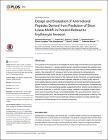| dc.contributor.author | BELL, ANGUS | en |
| dc.date.accessioned | 2015-12-09T11:25:10Z | |
| dc.date.available | 2015-12-09T11:25:10Z | |
| dc.date.created | 2015 | en |
| dc.date.issued | 2015 | en |
| dc.date.submitted | 2015 | en |
| dc.identifier.citation | Bianchin A, Bell A, Chubb A.J, Doolan N, Leneghan D, Stavropoulos I, Shields D.C, Mooney C, Design and evaluation of antimalarial peptides derived from prediction of short linear motifs in proteins related to erythrocyte invasion, PLoS ONE, 10, 6, 2015 | en |
| dc.identifier.other | Y | en |
| dc.identifier.uri | http://hdl.handle.net/2262/75118 | |
| dc.description.abstract | The purpose of this study was to investigate the blood stage of the malaria causing parasite, Plasmodium falciparum, to predict potential protein interactions between the parasite merozoite and the host erythrocyte and design peptides that could interrupt these predicted interactions. We screened the P. falciparum and human proteomes for computationally predicted short linear motifs (SLiMs) in cytoplasmic portions of transmembrane proteins that could play roles in the invasion of the erythrocyte by the merozoite, an essential step in malarial pathogenesis. We tested thirteen peptides predicted to contain SLiMs, twelve of them palmitoylated to enhance membrane targeting, and found three that blocked parasite growth in culture by inhibiting the initiation of new infections in erythrocytes. Scrambled peptides for two of the most promising peptides suggested that their activity may be reflective of amino acid properties, in particular, positive charge. However, one peptide showed effects which were stronger than those of scrambled peptides. This was derived from human red blood cell glycophorin-B. We concluded that proteome-wide computational screening of the intracellular regions of both host and pathogen adhesion proteins provides potential lead peptides for the development of anti-malarial compounds. | en |
| dc.description.sponsorship | This work was supported by Science
Foundation Ireland
http://www.sfi.ie/
(grant numbers
08/IN.1/B1864, 10/RFP/GEN2749) to DCS and CM
and Irish Research Council
http://www.research.ie/
(UCD Bioinformatics and System Biology PhD
programme) to A. Bianchin and AJC. The funders
had no role in study design, data collection and
analysis, decision to publish, or preparation of the
manuscript | en |
| dc.relation.ispartofseries | PLoS ONE | en |
| dc.relation.ispartofseries | 10 | en |
| dc.relation.ispartofseries | 6 | en |
| dc.rights | Y | en |
| dc.subject | anti-malarial | en |
| dc.subject.lcsh | anti-malarial | en |
| dc.title | Design and evaluation of antimalarial peptides derived from prediction of short linear motifs in proteins related to erythrocyte invasion | en |
| dc.type | Journal Article | en |
| dc.type.supercollection | scholarly_publications | en |
| dc.type.supercollection | refereed_publications | en |
| dc.identifier.peoplefinderurl | http://people.tcd.ie/abell | en |
| dc.identifier.rssinternalid | 104374 | en |
| dc.identifier.doi | http://dx.doi.org/10.1371/journal.pone.0127383 | en |
| dc.rights.ecaccessrights | openAccess | |
| dc.identifier.rssuri | http://www.scopus.com/inward/record.url?eid=2-s2.0-84935025230&partnerID=40&md5=6143058fd173eea02eb6585aeda69357 | en |
| dc.contributor.sponsor | Science Foundation Ireland (SFI) | en |
| dc.contributor.sponsorGrantNumber | 08/IN.1/B1864 | en |
| dc.contributor.sponsor | Science Foundation Ireland (SFI) | en |
| dc.contributor.sponsorGrantNumber | 10/RFP/GEN2749 | en |




